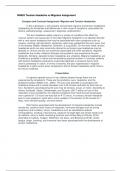NR603 Tension Headache vs Migraine Assignment
Compare and Contrast Assignment: Migraine and Tension Headaches
In this submission, I will compare and contrast migraine and tension headaches
highlighting the similarities and differences in their onset of symptoms, associated risk
factors, pathophysiology, assessment, diagnosis, andtreatment.
The term headache widely refers to a variety of conditions that affect the
nervous system and cause pain in the head. Migraine headache is an episodic disorder
with a very severe headache that may be associated with other symptoms such as
nausea, vomiting, light sensitivity, temporary vision loss, painbehind the ears, eyes, and
in the temples (Mattle, Nedeltchev, Schankin, & Jung,2020). On the other hand, tension
headaches which are also commonly referred to as tension-type headaches may be
episodic or chronic and are not commonly associated with other symptoms. Migraine
headaches are mostly unilateral although some patients may experience the pain
bilaterally. Similarly, episodic tension headaches are unilateral. Migraine headaches are
throbbing or pulsatile in nature and worsened by physical exertion. In contrast, patients
with tension headaches experience a band-like tightness or pressure that is more
chronic andsteady in nature. In terms of severity, the pain experienced in migraine
headaches is quite severe when compared to that of tension headaches which tend to
be mild to moderate.
Presentation
A migraine episode occurs in four distinct phases though these are not
experienced by all patients. These are the prodrome, aura, headache, and the
postdrome phase (Mattle et al., 2020). The aura may precede or accompany the
headache phase and it usually develops over 5-20 minutes and lasts for less than an
hour. Symptoms accompanying the aura may be sensory, visual, or motor. According to
Ascha, Kurlander, Sattar, Gatherwright, and Guyuron (2017),within an hour of the
resolution of aura symptoms, the migraine symptoms kick inand the pain progresses
over a period of 1-2 hours and may last for 4-72 hours. In contrast, tension headache
pain is more gradual in onset with a more variable in the duration of 30 minutes to 7
days, more constant quality, and less severe.
Risk factors associated with the development of migraine headaches include
female sex, positive family history of migraines, hormonal changes such as during
pregnancy and ovulation, stress, medications such as vasodilators andoral
contraceptives, smoking, head trauma, exposure to bright light and certain foods such
as caffeine, citrus or foods containing tyramine and nitrites (May & Schulte, 2016).
According to Ligthart, Huijgen, Willemsen, De Geus, and Boomsma (2018), stress,
fatigue, anger, smoking, and insomnia have been associated with the development of
tension headaches.




